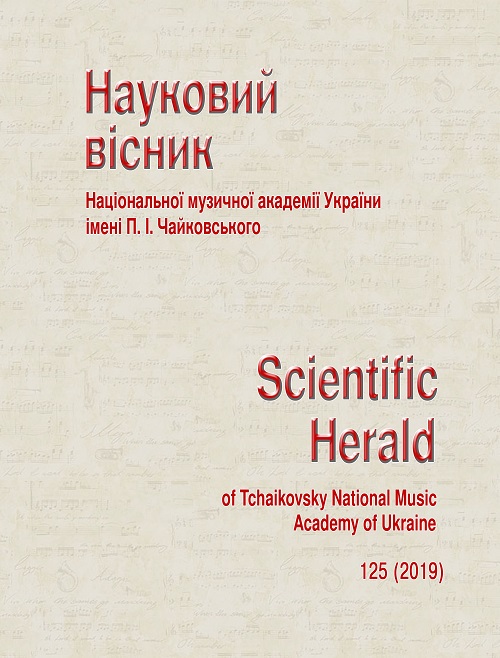Issues Concerning The Transformation of Rhythm Archetype in Stanislav Liudkevych's Creative Work: Through the Early Style Evolvement
DOI:
https://doi.org/10.31318/2522-4190.2019.126.197969Keywords:
genres of creative work, colomies (kolomyika), S. Liudkevych’s early style, rhythm archetype transformationAbstract
Relevance of the study. The kolomyjka archetype in Ukrainian culture is one of the dominant and most ancient. Its highest concentration was found in the Carpathian region, where it became the mode of thinking in the ethnic environment. The Eastern Galicia composers use this archetype actively. Novelty of the article is the first attempt to analyse the semantics and modification methods of the kolomyjka rhythm structure in S. Liudkevych works written in the early period of his creative work (1897–1919).
Main objectives of the study — to identify the specificity of the kolomyjka archetype functioning in terms of Liudkevych’s early work.
Methodology: the research of kolomyjka rhythm is based on the methods of rhythm musical-theoretical analysis and comparative analysis.
Results and conclusions. One of the most ancient in Ukrainian culture rhythmic archetype and its transformation in S. Liudkevych works is considered as an important stylistic factor in his early style formation. The kolomyjka rhythm structure is analysed in compositions representing different genres of creative work: solo and choral adaptation of folk songs, piano pieces, variation cycles, piano trio, cantata symphony “Caucasus”. The specificity of the archetype interpretation is shown in terms of the composer’s early creative work. Typically, a final six-component rhythm group of kolomyjka undergoes modification. Its various modifications found in the form of rhythmic augmentations and diminutions (expansions and compressions) of four-component, often asymmetric groups, which repeatedly lose a link with the initial standard form. The prolongation of this structure of separate groups and its doubling in order to specify the important semantic signs of “Caucasus” musical poetics is aimed at adequately reproducing of Shevchenko’s poetry features.
The kolomyjka archetype, blending with other rhythmic structures in the early Liudkevych style, is interpreted most distinctly, falling under conditions of close interaction of the iambic and choreus structures, internal syllable chanting, non-periodic rhythm, pair and odd time and complex polyphonic forms (fugue). It undergoes numerical transformations semantically distant from the original archetype. In the context of late-romantic dramaturgy of a monothematic type, its presence is characterized as a basis for the typically national genres of folk and professional musical art (ballad, Old Galician elegy, choral concert, urban cantus of the Baroque Age), as well as genre models shaped by the European musical tradition of the 17–19 centuries (saraband, mourning march,
waltz). Liudkevych’s innovative findings in the field of national-characteristic rhythms were continued and developed by the following generations of Ukrainian composers (M. Kolessa, N. Nyzhankivsky, M. Skoryk, E. Stankovych, O. Kozarenko).
Significance. The study of the innovative features of Liudkevych’s early style in the rhythm national-characteristic forms transformation showed extraordinary invention capability in interpreting kolomyjka archetypes, became an example for its elaboration by the younger generations of Ukrainian composers, and provided the possibility to consider its functioning in the works by foreign composers of Central and Eastern Europe.
References
Antonovych, M. (1999). Stanislav Liudkevych: composer and musicologist [Stanislav Liudkevych: kompozytor i muzykolog]. Lvіv: Spilka kоmpоzytoriv Ukrayiny, 1999. 60 s. [In Ukranian].
Goshovskij, V. (1971). At the origins of Slavic folk music: essays on musical Slavic studies [U istokov nаrоdnoj muzyki slavian: оchеrki pо muzykalnomu slavianoviedieniyu]. Моskvа: Sоviеtskij kоmpоzitоr. 303 s. [In Russian].
Grytsa, S. Yo. (1979). Melodies of the Ukrainian folk epic. [Mеlоs ukrayinskoyi narodnoyi epiky]. Кyiv: Naukova dumkа, 1979. 246 s. [In Ukranian].
Zіnkіv, І. (2011). Коlоmies in the Stanіslav Liudkevych’ creative work [Kolomyika v tvorchosti Stanislava Liudkevycha]. Bulletin of the Carpathian university. [Vіsnyk Prykarpats’koho universytetu. Sеriya: Мystetstvoznavstvo]. Іssue: Art studies. Vol. 21–22. Іvаnо-Frаnkіvs’k. pp. 132–138 [In Ukranian].
Zіnkіv, І. (2013). Bandura as historic phenomenon: monography [Bandura yak istorychnyj fenomen: monografiya]. Кyiv: NАNU, ІМFЕ іm. М. Т. Ryl’skogo. 448 s. [In Ukranian].
Liudkevych, S. (1999). Singing and melodic bases and signs of Taras Shevchenko's poetry [Spivnі tа mеlоdіynі оsnоvy і prykmety pоеziyi Т. Shеvchеnkа]. In: Liudkevych, S. Researches, articles, reviews, speeches [Liudkevych, S. Dоslidzhennia, statti, retsenziyi, vystupy], 2 volumes, ed. Z. Shtunder. Lvіv: Vydavnytstvо М. P. Коts’, 1999. Т. 1, pp. 246–254 [In Ukranian].
Liudkevych, S. (1974). Bases and significance of melodiousness in Taras Shevchenko’s poetry [Pro оsnovu і znаchеnnia spіvnоstі v pоеzіyi Таrаsа Shеvchеnkа] In: Liudkevych, S. Researches and Articles [Liudkevych S. Dоslіdzhеnnia і stаttі, ed. М. М. Gоrdiychuk]. Кyiv: Мuzychnа Ukrayina, pp. 107–126 [In Ukranian].
Shtunder, Z. (2005) Stanislav Liudkevych: Life and Creative Work. [Stаnіslаv Liudkevych. Zhyttia і tvorchist’]. Vol. І (1870–1939). Lvіv: Bіdаr — 2000. 635 s. [In Ukranian].
Yakubiak, Ya. (2003) Mykola Lysenko and Stanislav Liudkevych [Мykola Lysenkо і Stаnіslаv Liudkevych]. Lvіv: NТSh, 2003. 264 s. [In Ukranian].


